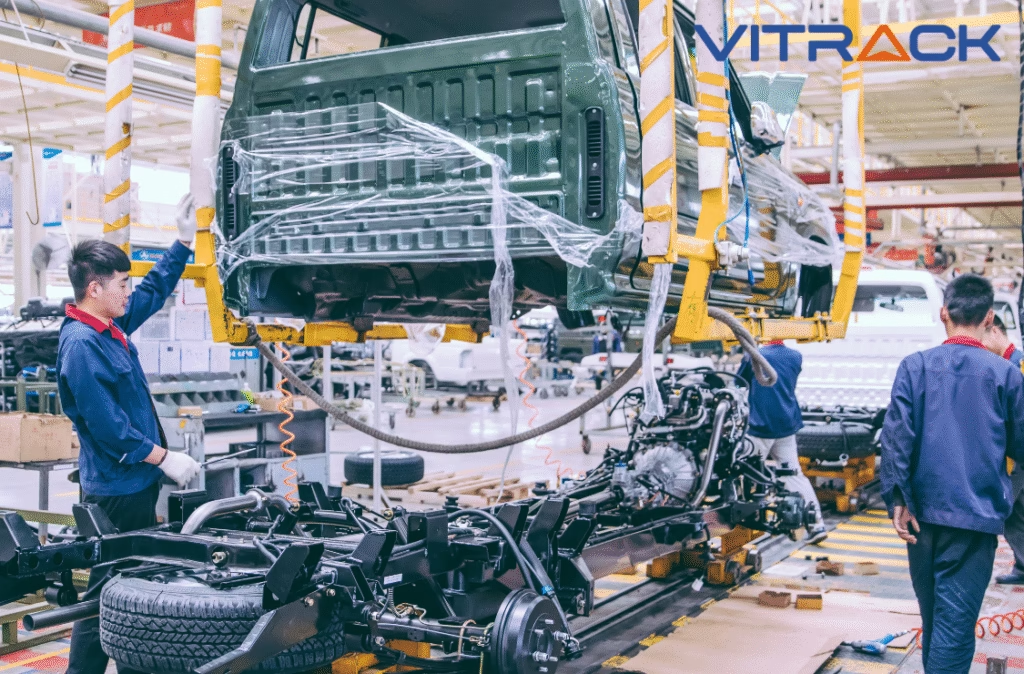Automotive assembly lines are extremely complex, with hundreds of parts, tools, and vehicles moving continuously. In this environment, even small disruptions can cascade into costly downtime. For example, specialized tools and dies often get misplaced on the shop floor, forcing workers to spend significant time searching. When essential equipment isn’t readily available, production lines stall, directly hurting throughput and delivery schedules. Traditional tracking methods (manual logs, barcodes or basic RFID) struggle to keep up with today’s scale and customization demands. Common pain points include:
- Frequent Tool Loss: Critical tools and dies are often misplaced across the plant, wasting minutes of production time.
- Production Downtime: Unavailable parts or equipment force lines to stop, reducing output and on-time delivery.
- Limited Visibility: Without real-time tracking, managers lack visibility into work-in-progress inventory and asset locations, creating bottlenecks.
- Safety Risks: Monitoring personnel in busy factories is challenging; keeping workers out of hazardous zones or locating them in emergencies requires better visibility.
These challenges are driving Digital Transformation in automotive plants, where plant managers seek IoT-based solutions. Real-Time Location Systems (RTLS) have emerged as a key technology to secure valuable assets and optimize operations.
What Is RTLS and How Does It Work?
A Real-Time Location System (RTLS) combines small wireless tags, anchors (sensors) and software to continuously determine the positions of tagged objects or people indoors. Think of it as an “indoor GPS.” Each tool, part, vehicle or staff member carries a tag (e.g. Ultra-Wideband or Bluetooth Low Energy) that periodically broadcasts signals. A network of receivers on the factory floor picks up these signals and triangulates the tag’s location in real time. The location data is sent to a centralized platform, where managers see live dashboards of all assets and can set up rules (geo-fences, alerts, analytics). Unlike barcode/RFID systems that only record static checkpoints, RTLS provides continuous, dynamic insight into every movement.
In practice, an RTLS platform integrates with a plant’s IT systems (MES, ERP, digital-twin, etc.) to trigger actions. For example, entering a tagged tool into a certain zone might automatically update work orders or quality checklists. Likewise, planners can pull reports on asset utilization, dwell times or bottlenecks from RTLS analytics. The result is a data-driven control loop: the system not only shows where things are, but helps automate processes and guide smarter decisions.
Tracking High-Value Tools and Assets
Automotive plants tag high-value tools, dies, jigs and even work-in-progress parts to eliminate losses. For instance, in one case study a plant attached RTLS tags to every precision die. This allowed managers to see each die’s exact location on a live dashboard. As a result, the average search time for a needed die fell from 15–20 minutes to about 30 seconds – essentially eliminating idle machine time. Key features of a tool-tracking RTLS include:
- Real-Time Asset Dashboard: Every tagged tool, part or container shows up on a map or list. Engineers instantly know the status and location of each item.
- Automated Alerts: If a tool is moved out of bounds or goes missing, the system sends instant notifications. Workers also receive alerts about the nearest available tool, minimizing hunt-time.
- Inventory Accuracy: Continuous tracking means always knowing how many of each tool or part are in use or on hand. This prevents stock-outs of critical equipment and reduces redundant spare stock.
Because of these capabilities, RTLS transforms tool management. Industry benchmarks show dramatic results: UWB RTLS deployments report up to 99% asset visibility (nearly eliminating “lost” tools) and ~30% reduction in downtime. One study noted a 25% boost in equipment utilization and 40% less manual tracking effort due to RTLS insights. In short, by tagging every expensive wrench, die and jig, factories recover hours per week of wasted labor and keep lines moving.
Tracking Vehicles, Inventory & Yard Management
RTLS isn’t limited to tools. Automotive OEMs use it to track entire vehicles and material flows. After assembly, cars often sit in large lots awaiting inspection or shipment. With RTLS tags on each vehicle, the factory has real-time visibility of its lot. Managers can instantly locate a specific VIN among hundreds of cars, greatly reducing search time.
Indoors, RTLS tracks kitting carts, AGVs or battery racks that feed the line. When every mobile cart has a tag, the system ensures materials arrive “just-in-time” at the correct station. If a cart lingers too long or goes astray, the system flags the delay. Overall, RTLS bridges gaps between inventory and production: finished vehicles, incoming parts, and large equipment are all tracked seamlessly.
Enhancing Worker Safety and Productivity
Automotive factories are busy and can be hazardous; worker location tracking is a natural extension of RTLS. Employees wear lightweight tags or badges that broadcast their position (often via Bluetooth or UWB). In real time, the system knows where every technician and visitor is on the shop floor. This enables powerful safety and efficiency features:
- Safety Geofencing: Managers set virtual zones around hazardous areas like robotic welders or presses. If anyone enters, the system triggers alarms or stops nearby machines, reducing accident risks.
- Emergency Response: During evacuations or incidents, supervisors can instantly check who’s inside or outside the facility. RTLS tracks personnel in real time, and wearable tags with SOS buttons allow workers to call for help and share their exact location.
- Workforce Optimization: RTLS improves productivity by dispatching tasks to the nearest qualified worker, cutting travel time. It also logs task start and end times, enabling better workforce planning. For example, if a car stalls, the system identifies and alerts the closest available mechanic.
According to industry experts, “people tracking is becoming increasingly important for the automotive industry” for exactly these reasons: it “ensures a safe environment for staff and enables the optimization of operational productivity”. In sum, tagging workers with RTLS not only enhances compliance but also drives smarter workforce management.
Technology Options: UWB, BLE and Beyond
RTLS solutions use different radio technologies depending on the requirement. Ultra-Wideband (UWB) is ideal for tracking high-value tools in dense, metal-filled factories as it delivers centimeter-level accuracy, typically within 10–30 cm. This makes it perfect for narrow aisles and critical operations.
On the other hand, Bluetooth Low Energy (BLE) and BLE AoA systems are more suitable for tracking people, vehicles, and general assets, offering meter-level accuracy. Many manufacturers prefer a combination of UWB and BLE — UWB for precision tracking of essential tools and BLE for broader asset and workforce management, ensuring the right balance of accuracy and affordability.
A typical RTLS system includes tags on tracked items, anchors or sensors installed around the plant, a software platform for live location data and analytics, and geofence alerts for defined zones — creating a reliable, real-time visibility layer across the factory.
Measurable Benefits and ROI
The business benefits of RTLS in automotive are substantial and measurable. By eliminating search time and preventing downtime, RTLS drives efficiency and cost savings. Industry research highlights several key impacts:
- Boosted Asset Visibility: One RTLS deployment achieved ~99% visibility of tagged assets, virtually eliminating “missing” tools. Workers spend far less time running around looking for equipment.
- Downtime Reduction: Studies report roughly 30% less downtime after adopting RTLS. With parts and tools always at hand, production stalls are greatly reduced.
- Higher Utilization: Knowing exactly what assets exist and how they move helps eliminate idle inventory. RTLS users have seen 25% better utilization of tooling and devices.
- Labor Savings: Manual searches and tracking tasks drop dramatically. One case saw 40% fewer labor hours spent on tracking and data entry. In another, automating tool checkouts cut the sign-off workload by 80%.
- Cost Reduction: All these gains translate to lower operating costs. Case studies show up to 20–30% overall cost savings from RTLS-driven process improvements.
For example, consider the tool-tracking deployment cited above: by slashing the average tool search from 15 minutes to half a minute, the plant essentially eliminated idle equipment time. A supervisor noted that receiving instant alerts about wrong tools on a job preempted costly errors. The net result was a smoother assembly flow and faster throughput.
Accelerating Digital Transformation with RTLS
Real-Time Location Systems (RTLS) have become an essential Industry 4.0 tool for automotive factories, offering real-time, actionable visibility of both assets and people. By addressing common challenges like tool misplacement, production delays, and safety risks, RTLS helps improve efficiency, reduce downtime, and enhance shopfloor safety.
Our RTLS solution is purpose-built for automotive plants, using rugged UWB/BLE tags and an intuitive dashboard, seamlessly integrating with ERP/MES systems. Manufacturers adopting our system have achieved up to 20% cost savings and significant gains in operational efficiency within months.
In today’s fast-paced, customized manufacturing environment, real-time tracking is a necessity. Get in touch with us to see how ViTrack Solutions can secure your assets, protect your workforce, and drive smarter, data-backed decisions on your shopfloor.




